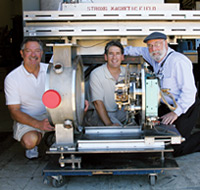Commentary: Herman Winick
 |
| From left, Richard Boyce, Charles Troxel Jr., and Herman Winick with equipment being sent from SLAC to SESAME. |
| Photo: Diana Rogers, SLAC |
Science and peace
Science is an international activity. It is elementary that communication and collaboration among scientists promote scientific progress. No group has a monopoly on good ideas. Stanford Linear Accelerator Centers Sid Drell is fond of quoting Chekov, who said, "There is no national science, just as there is no national multiplication table; what is national is no longer science."
Collaboration and communication among scientists from countries or ethnic groups that are at odds with one another has value beyond this, by lowering tensions and contributing to improved understanding. Scientists were prominent among the thousands of American and Soviet citizens who visited each other during the Cold War, helping create the atmosphere that led to glasnost and the lifting of the Iron Curtain. Accelerator physicists, particle physicists, and synchrotron radiation users were strongly involved. CERN, the European particle physics laboratory near Geneva, Switzerland, played a particularly strong role in this, and is itself a premier example of how scientific cooperation helps overcome tensions among countries that were recently at war.
Pief Panofsky worked tirelessly to strengthen communication with scientists in the Soviet Union and China, and, until his death on Sept. 24, 2007, with Iran. In his new autobiography, Panofsky on Physics, Politics, and Peace, he recounts how scientific exchanges played a role in reaching agreements on arms control. Describing his first visit to the Soviet Union in 1956, he says, "This visit began a new era of communications in high-energy physics. Vladimir Veksler, the Russian co-inventor of phase stability, was invited to the next Rochester conference in the United States, and there he gave a memorable talk in which he remarked, There are now three branches of physics: experimental physics, theoretical physics, and diplomatic physics."
Channels of communication are much needed today in many parts of the world, including the Middle East. Science is filling part of this need. In addition to several bilateral projects bringing together scientists from Israel and its Islamic neighbors, the SESAME project is bringing together ten countries to build a research center in Jordan, closely modeled on CERN. The centerpiece of SESAME, a new 2.5 GeV third-generation synchrotron radiation source, is under construction.
Members of the SESAME Council—representing Bahrain, Cyprus, Egypt, Iraq (membership in process), Iran, Israel, Jordan, the Palestinian Authority, Pakistan, and Turkey—have responsibility for the project. They have met twice each year since 1999, with Herwig Schopper, former director-general of CERN, as president. Next summer Chris Llewellyn-Smith, also a former director-general of CERN, will take over from Schopper, who steps down at age 84.
SESAME has made steady progress since its inception, in spite of the fact that scientists from both Islamic countries and Israel face criticism (and sometimes severe pressure, threats, and more) from people who deplore cooperation with the "enemy." The SESAME building, funded by Jordan, is complete, and installation of the bessy i 0.8 GeV injection system, a gift from Germany, will soon start, as orders are placed for components of the new electron storage ring. Surplus equipment is being sent to SESAME from synchrotron radiation laboratories at Daresbury (UK), Orsay (France), Lawrence Berkeley National Laboratory (US), and Stanford Linear Accelerator Center (US). First operation is scheduled for 2010.
SESAME has been nurtured by the United Nations Educational, Scientific and Cultural Organization, the neutral umbrella under which CERN was created. In approving SESAME, the unesco Executive Board and General Assembly called it "a quintessential unesco project combining capacity building with vital peace-building through science."
Hundreds of scientists and government officials from the Middle East have met at Council meetings, users meetings, workshops, and schools, leading to friendships and collaborations. It is likely that these relationships are contributing to a better understanding among these countries, some of which do not have diplomatic relations.
SESAME stands in stark contrast to efforts to suppress such contacts by some scientific and academic groups, such as the American Chemical Societys expulsion of Iranian members and the boycott of Israeli academics proposed by the University and College Union of the United Kingdom. Fortunately, strong criticism of both of these has led to rescinding of the first and at least a delay of the second.
Herman Winick played a strong leadership role in the development of synchrotron radiation sources and research at Stanford and around the world. Since retiring as deputy director of the Stanford Synchrotron Radiation Laboratory, he has continued to work on international science, academic freedom, and human rights, focusing largely on SESAME, which he began with Gus Voss from Germanys DESY lab in 1997.
For information on SESAME, see www.sesame.org.jo and the Dec 2004 issue of symmetry.
Click here to download the pdf version of this article.


